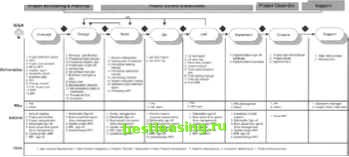

 |
 |

|
Промышленный лизинг
Методички
is needed that can show value and reflect the corporate strategy goals and objectives. The project team, armed with the right tools, techniques, and methodology, can keep the client involved and improve the bottom line. The methodology can be adjusted to fit the solution. The Standish Groups landmark 2000 report, Chaos in the New Millennium, reports that outright project failures declined from 40 percent to 23 percent during the past five years but challenged projects swelled from 33 percent to 49 percent in the same period. Reasons listed included cost overruns and projects with lower functionality than promised. The correct choice of methodology plays an important part in elevating the rate of failures (see Figure 4.2).  Figure 4.2: New product development process. Requirements for Selecting a Methodology Table 4.1 illustrates essential decisions a project manager must make when selecting a methodology: Budget. Budgets play a big role in any project, and the type of methodology to be used is key. For example, you have been given a mandate to develop a product within eight months. Your sponsor says, Money is no problem; we need this product by the end of the year. If you select a heavy methodology, you may not achieve your goal because you will see the results only near the end of the project. (Earned value could possibly help, too.) A light, agile methodology may be the more appropriate choice because many of the lightweight methodologies are done in iterations and budgeted accordingly. If the project appears to be failing, funding is discontinued; if the iteration proves successful, funding for the next release is approved and work continues. Team size. Methodologies are directly proportional to the team size use light methodologies for smaller teams and heavy methodologies for larger teams. Projects with teams of 100 members geographically dispersed throughout the globe will not work using a small, lightweight methodology. The lines of communication grow more complex with the increase in team size, necessitating a more disciplined, coordinated model. For example, the Boston Big Dig project, the largest underground artery roadwork project in U.S. history estimated at $14.5 billion for 7.5 miles of highway requires thousands of workers across many vendors and employment agencies. A lightweight methodology is not suited to such a project. Technology used. The technology used on a project affects the direction and type of methodology selected. Unfamiliar technology slows progress. On many projects today, simulation and testing of new technologies is actually considered a phase of the methodology. Tools and techniques. Some project methodologies require more tools and techniques than others for example, databases, visual modeling tools, and project management tools; some require hardly anything. If a project manager must manage multiple design changes, he or she will need a configuration management tool and technique. Table 4.1: Requirements for selecting a methodology
Project criticality. Any critical project with a must-deliver target date needs to have the correct choice of methodology. The project might require additional resources to finish by the required date. If the methodology is too small, the project manager loses control; too large and formal, he or she slows the project down. A project managers experience and skills will help in choosing the best approach. Existing processes. In any company, the maturity and ease of use of existing project processes largely influence the methodology. Some company processes may be totally unreliable and ad hoc, slowing down completion of tasks. For example, you follow the standard internal purchasing process, which has a lead time of two months to receive goods. This process requires intervention or change.
No two methodologies are ever quite the same. At last count, my research on this topic found 45 different methodologies. If you dont have any methodologies in place in your company, on your next project, begin documenting issues and steps. Each major event (e.g., design) symbolizes either an end to a phase or the beginning of the next phase. All phases have unique activities and deliverables from previous activities. Before moving to the next phase, make sure all the activities and deliverables are completed. If you dont, expect to have more problems than usual. PREVIOUS NEXT ► 1 2 3 4 5 6 7 8 9 10 11 12 13 14 15 16 17 18 19 20 21 22 23 24 25 26 27 28 29 30 31 32 [ 33 ] 34 35 36 37 38 39 40 41 42 43 44 45 46 47 48 49 50 51 52 53 54 55 56 57 58 59 60 61 62 63 64 65 66 67 68 69 70 71 72 73 74 75 76 77 78 79 80 81 82 83 84 85 86 87 88 89 90 91 92 93 94 95 96 97 98 99 100 101 |